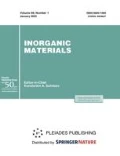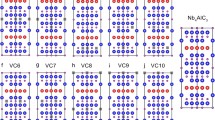Abstract
The crystal structures of the tungsten monocarbide δ-WC and the disordered lower carbide β-W2C are studied. Using magnetic susceptibility measurements, the hexagonal carbide δ-WC is shown to be stable from 300 to 1200 K. The sequence of phase transformations associated with β-W2C ordering is analyzed. The temperature and composition stability limits of the cubic carbide γ-WC1−x are evaluated, and the first data are presented on the variation of its lattice parameter with composition. An optimized W-C phase diagram is proposed which takes into account detailed structural and phase-equilibrium data for tungsten carbides.
Similar content being viewed by others
References
Gusev, A.I. and Rempel, A.A., Nestekhiometriya, besporyadok i poryadok v tverdom tele (Nonstoichiometry, Disorder, and Order in Solids), Yekaterinburg: Ural. Otd. Ross. Akad. Nauk, 2001.
Gusev, A.I., Rempel, A.A., and Magerl, A.J., Disorder and Order in Strongly Nonstoichiometric Compounds: Transition Metal Carbides, Nitrides, and Oxides, Berlin: Springer, 2001.
Storms, E.K., The Refractory Carbides, New York: Academic, 1967. Translated under the title Tugoplavkie karbidy, Moscow: Atomizdat, 1970.
Moissan, H., Préparation au four électrique de quelques métaux réfractaires: tungstène, molybdène, vanadium, Compt. Rend., 1893, vol. 116, pp. 1225–1227.
Rudy, E. and Windisch, S., Evidence to Zeta Fe2N-Type Sublattice Order in W2C at Intermediate Temperatures, J. Am. Ceram. Soc., 1967, vol. 50, no. 5, pp. 272–273.
Rudy, E., Compendium of Phase Diagram Data. Ternary Phase Equilibria in Transition Metal-Boron-Carbon-Silicon Systems, Report AFML IR-65-2, Wright-Patterson Air Force Base (Ohio), 1969.
Rudy, E. and Hoffman, J.R., Phasengleichgewichte im Bereich der kubischen Karbidphase im System Wolfram-Kohlenstoff, Planseeber. Pulvermetall., 1967, vol. 15, no. 3, pp. 174–178.
Sara, R.V., Phase Equilibrium in the System Tungsten-Carbon, J. Am. Ceram. Soc., 1965, vol. 48, no. 5, pp. 251–257.
Rempel, A.A., Würschum, R., and Schaefer, H.-E., Atomic Defects in Hexagonal Tungsten Carbide Studied by Positron Annihilation, Phys. Rev. B: Condens. Matter, 2000, vol. 61, no. 9, pp. 5945–5948.
Klemm, W. and Schüth, W., Magnetochemische Untersuchungen: 3. Über den Magnetismus einiger Carbide und Nitride, Z. Anorg. Allg. Chem., 1931, vol. 201, no. 1, pp. 24–31.
Lander, J.J. and Germer, L.H., Plating Molybdenum, Tungsten, and Chromium by Thermal Decomposition of Their Carbonyls, Trans. AIME, 1948, vol. 175, pp. 661–691.
Lautz, G. and Schneider, D., Über die Supraleitung in den Wolframkarbiden W2C und WC, Z. Naturforsch., A, 1961, vol. 16, no. 12, pp. 1368–1372.
Parthe, E. and Sadagopan, V., The Structure of Dimolybdenum Carbide by Neutron Diffraction Technique, Acta Crystallogr., 1963, vol. 16, no. 3, pp. 202–205.
Butorina, L.N. and Pinsker, Z.G., Electron Diffraction Study of W2C, Kristallografiya, 1960, vol. 5, no. 4, pp. 585–588.
Rudy, E., Windisch, S., and Hoffman, J.R., W-C System: Supplemental Information on the Mo-C System. Ternary Phase Equilibria in Transition Metal-Boron-Carbon-Silicon Systems (Part I. Related Binary Systems, vol. VI), Report AFML-TR-65-2, Wright-Patterson Air Force Base (Ohio), 1966, pp. 1–50.
Goldschmidt, H.J. and Brand, J.A., The Tungsten-Rich Region of the System Tungsten-Carbon, J. Less-Common Met., 1963, vol. 5, no. 2, pp. 181–194.
Ronsheim, P., Toth, L.E., Mazza, A., et al., Direct Current Arc-Plasma Synthesis of Tungsten Carbides, J. Mater. Sci., 1981, vol. 16, no. 10, pp. 2665–2674.
Willens, R.H. and Buehler, E., The Superconductivity of the Monocarbides of Tungsten and Molybdenum, Appl. Phys. Lett., 1965, vol. 7, no. 1, pp. 25–26.
Willens, R.H., Buehler, E., and Matthias, B.T., Superconductivity of the Transition-Metal Carbides, Phys. Rev., 1967, vol. 159, no. 2, pp. 327–330.
Krainer, E. and Robitsch, J., Röntgenographischer Nachweis des kubischen Wolframkarbides in funkenerosiv bearbeiteten Hartmetallen und in reinen Wolframschmelkarbiden, Planseeber. Pulvermetall., 1967, vol. 15, no. 1, pp. 46–56.
Krainer, E. and Robitsch, J., Zur Frage des kubischen Wolframkarbids, Planseeber. Pulvermetall., 1967, vol. 15, no. 3, pp. 179–180.
Author information
Authors and Affiliations
Additional information
Original Russian Text © A.S. Kurlov, A.I. Gusev, 2006, published in Neorganicheskie Materialy, 2006, Vol. 42, No. 2, pp. 156–163.
Rights and permissions
About this article
Cite this article
Kurlov, A.S., Gusev, A.I. Tungsten carbides and W-C phase diagram. Inorg Mater 42, 121–127 (2006). https://doi.org/10.1134/S0020168506020051
Received:
Accepted:
Issue Date:
DOI: https://doi.org/10.1134/S0020168506020051



